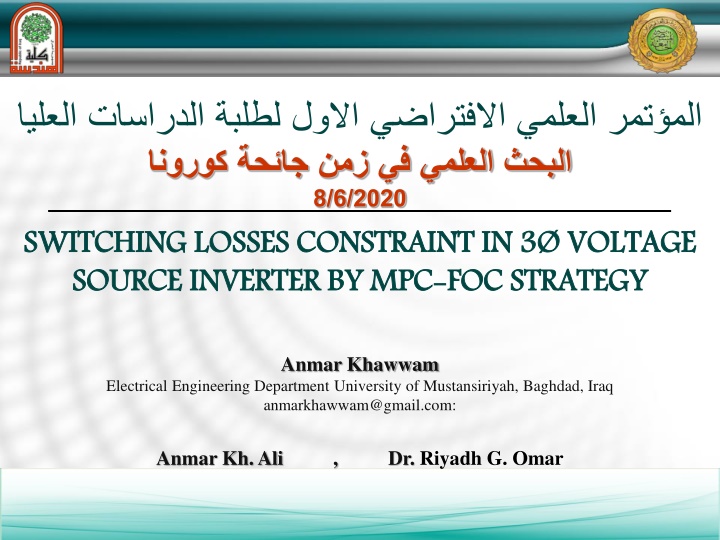
Switching Losses Constraint in Voltage Source Inverter by MPC FOC Strategy
Learn about reducing power losses in inverters through switching losses constraints in a 3 voltage source inverter using Model Predictive Control (MPC) and Field-Oriented Control (FOC) strategy. Discover how to enhance inverter performance, improve cooling conditions, and minimize losses from switching devices.
Download Presentation

Please find below an Image/Link to download the presentation.
The content on the website is provided AS IS for your information and personal use only. It may not be sold, licensed, or shared on other websites without obtaining consent from the author. If you encounter any issues during the download, it is possible that the publisher has removed the file from their server.
You are allowed to download the files provided on this website for personal or commercial use, subject to the condition that they are used lawfully. All files are the property of their respective owners.
The content on the website is provided AS IS for your information and personal use only. It may not be sold, licensed, or shared on other websites without obtaining consent from the author.
E N D
Presentation Transcript
8/6/2020 SWITCHING LOSSES CONSTRAINT IN 3 VOLTAGE SOURCE INVERTER BY SWITCHING LOSSES CONSTRAINT IN 3 VOLTAGE SOURCE INVERTER BY MPC MPC- -FOC FOC STRATEGY STRATEGY Anmar Khawwam Electrical Engineering Department University of Mustansiriyah, Baghdad, Iraq anmarkhawwam@gmail.com: Anmar Kh. Ali , Dr. Riyadh G. Omar
Introduction Power losses in inverters occur primarily in semiconductor components (IGBTs), and their freewheeling diodes. The overall losses in any switching device are power when the switch is conducting, and the losses produced from switching. Conducting losses is hard to control since it depends on IGBT manufacturers. The losses from switching can be minimized by adding predefined constraints to the cost-function in the MPC strategy. The main goals of the control algorithm are: losses reduction, enhances the inverter s performance, and improve cooling conditions. 8/6/2020 Baghdad, Iraq 2
The cost-function in the model predictive control (MPC) represents the number of differences between the required reference value and its predicted value. Mathematical representation of the cost-function is : ? ? = ?(?) ?(?) The cost-function depends on the required accuracy, the execution time, and the number of terms included in it. One example of direct current control for 3 systems can be implemented with two-axis currents ? ? ? = ??(?) ??(?) + ??(?) ??(?) 8/6/2020 Baghdad, Iraq 3
Dynamic Power Losses Dynamic power losses in the IGBT consists of losses from switches and losses from drivers. The switching losses are the sum of the upper and lower IGBT loss when these transistors in the ON / OFF state. Figure 1: Basic model for estimating losses from switches 8/6/2020 Baghdad, Iraq 4
ON/OFF State Losses Measurement for S1 IGBT A Matlab / Simulink simulation model is developed to compute the switching losses as shown in figures below: Figure 2: Power loss without Constraint Figure 3: Power loss with Constraint 8/6/2020 Baghdad, Iraq 5
A rise detector for gating signal S1 was developed to calculate the sum of the upper IGBT turn on/off cycles. To detect whether the upper IGBT in ON state or not is accomplished by recognizing the current polarity. The rising current gives a positive polarity and so on. the model has to compute the numbers of this rising current occurrence which means the numbers of ON/OFF states for this transistor. To compute the upper IGBT ON/OFF state power losses: ? 225 10 3 1 ?? ?=1 ??? 600 ? ? = 750 8/6/2020 Baghdad, Iraq 6
Results and Discussion The Matlab/Simulink 2019 package is used in simulation. The system parameters are: J = 3.1 kg.m2, p = 2, Lm = 10.46 mH, Ls = 0.3027 mH, Lr = 0.3027 mH, Rs = 14.85 m , Rr = 9.295 m , Nominal Torque = 792 Nm, Nominal Flux = 0.73 wb, Ts = 2 s. To decide if the above-proposed constraint work or not, a simulation model is used to calculate the power loss in switches and compare it before and after applying constraint. The algorithm that decides and chooses the best voltage vector that gives the minimum cost- function shown in figure 4. 8/6/2020 Baghdad, Iraq 7
Figure 4: Flow chart of the proposed constraint 8/6/2020 Baghdad, Iraq 8
Figure 5: Generated reference 3- currents 8/6/2020 Baghdad, Iraq 9
Figure 6: Measured 3- currents without constraint 8/6/2020 Baghdad, Iraq 10
Figure 7: Measured 3- currents with constraint 8/6/2020 Baghdad, Iraq 11
Figure 8: THD (2.87%) without constraint 8/6/2020 Baghdad, Iraq 12
Figure 9: THD (3.02%) with constraint 8/6/2020 Baghdad, Iraq 13
Figure 10: Optimum Value of Vector without constraint 8/6/2020 Baghdad, Iraq 14
Figure 11: Optimum Value of Vector with constraint 8/6/2020 Baghdad, Iraq 15
Conclusions Switching losses in converter switches depend directly on the frequency of IGBT switches. A proposed constraint is added to the cost-function to reduce these switching losses by discarding any switching states that contain the highest losses. The results show a notable reduction in switch losses. The proposed algorithm has a drawback of increasing the output of current harmonic content slightly. This constraint may be useful with applications that can tolerate more values of THD. 8/6/2020 Baghdad, Iraq 16
Thank you for your Attention Thank you for your Attention 8/6/2020 Baghdad, Iraq 17








